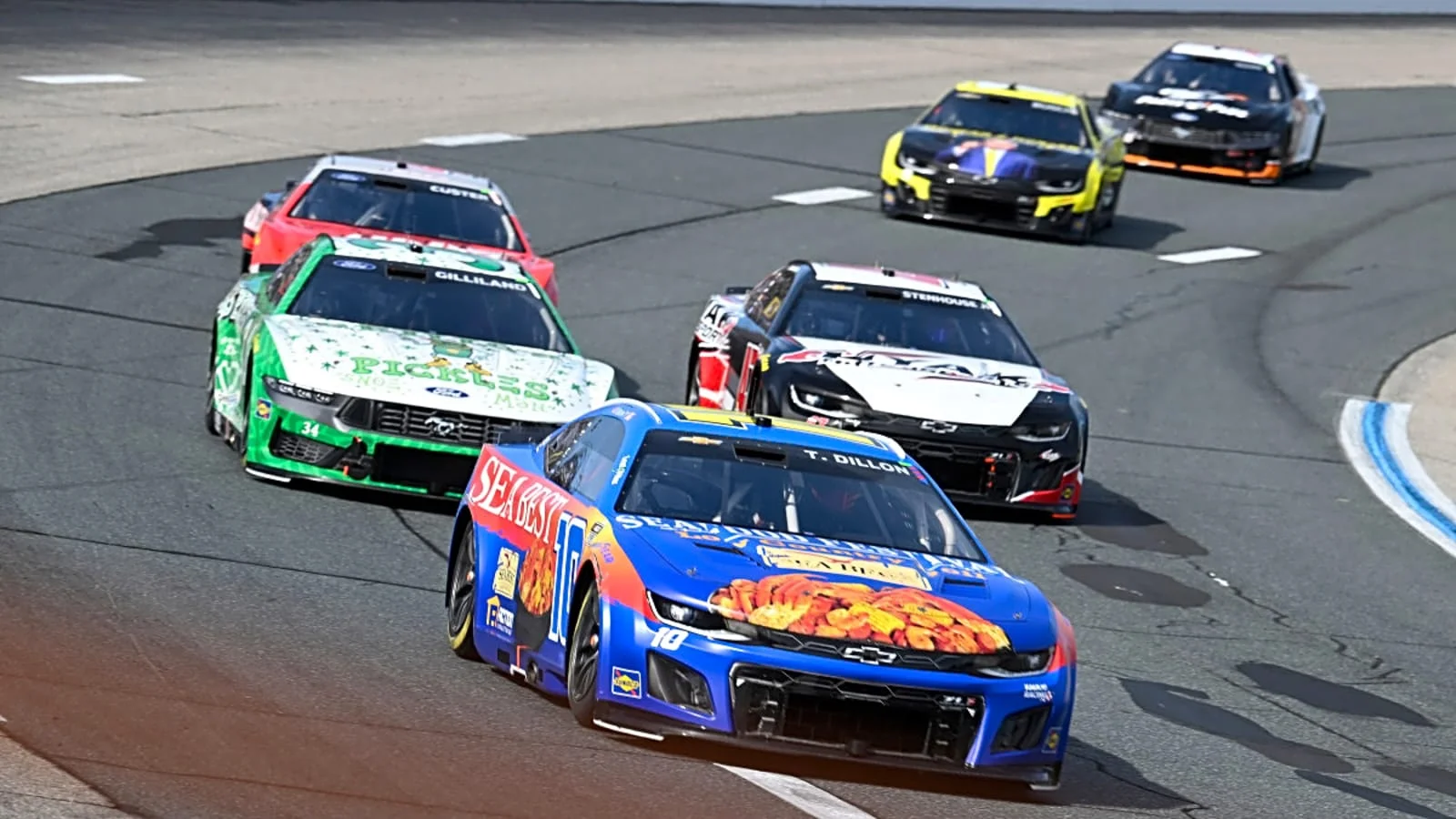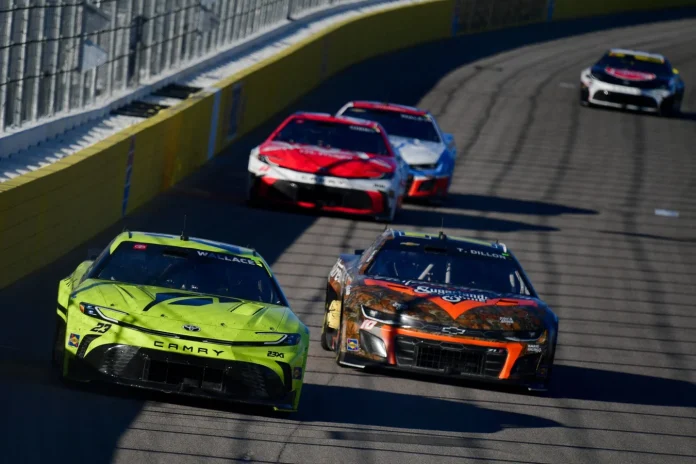Ty Dillon’s Las Vegas crash has ignited intense backlash among NASCAR fans, following the dismissal of his spotter Joe White from Kaulig Racing just days after the incident. The Ty Dillon Las Vegas crash, which ended William Byron’s race and altered playoff standings, has brought confusion and heated debate over where blame truly lies and how communication breakdowns occurred on the track.
Kaulig Racing Acts Quickly After Playoff-Altering Incident
Kaulig Racing CEO Chris Rice announced on Wednesday that Frank Deiny will assume spotting duties for Dillon’s No. 10 Chevrolet, replacing the recently dismissed Joe White. Meanwhile, T.J. Bell will cover spotting responsibilities for the team’s No. 16 Chevrolet at the upcoming event, referred to as The Tricky Triangle.
This immediate shift in personnel comes after a highly disputed moment during the South Point 400 at Las Vegas Motor Speedway. With only 32 laps left, William Byron, running in second place, collided with the slower car of Ty Dillon as Dillon attempted to enter pit road, resulting in a devastating accident for both Chevrolets and eliminating Byron from the playoff race. The consequences quickly became larger than a single race, affecting season standings and fan perceptions across the sport.
Breakdown of Communication Sparks Widespread Frustration
After the crash, it was revealed that Joe White, Dillon’s spotter, attempted to communicate the impending pit stop to Byron’s team while on the spotter stand. However, due to a communication breakdown or misinterpretation, Byron did not receive the warning in time, leading to the crash. Addressing the situation on social media after The Athletic confirmed his removal, Joe White stated:

“Just to be clear, here is the story of what happened last Sunday. I did in fact go down and tell the spotter of the 24 that we were pitting, and he misinterpreted the information. That’s what happened.”
– Joe White, Spotter
The online NASCAR community erupted after White’s statement, with a significant segment of fans defending him, pointing out that a simple miscommunication between the Kaulig Racing and Hendrick Motorsports teams should not have led to White’s dismissal from his role. Some fans sharply criticized the Hendrick camp, accusing them of shifting blame unduly, as one attested:
“Typical Hendrick driver/team, they’d blame their own family if they could.”
– Unattributed NASCAR Fan
Nonetheless, other fans argued that William Byron’s spotter, Brandon Lines, had been correct to expect clearer notifications on an event as crucial as entering pit road, especially given the speed differences on track. They insisted that the onus was on Ty Dillon’s team to ensure their intentions were unmistakably communicated and carried out safely.
Conflicting Accounts From the Teams Involved
Once the South Point 400 concluded, both William Byron and Ty Dillon publicly commented, providing sharply contrasting interpretations of events. Byron maintained that he received no indication of Dillon’s intent to pit and had no awareness that the No. 10 Chevrolet was slowing on the backstretch. Dillon disputed this, continuing to emphasize that the right message was sent, but not understood as intended.
Joe White provided more detail in an extended interview, clarifying his own actions in the moments leading up to the crash:
“I didn’t get to him. I didn’t touch him on the shoulder, turn him around, but I got, I would say, four or five feet from him… I pointed to the bottom twice and mouthed the words ‘we’re pitting,” White explained, via The Athletic. “Obviously, that was misunderstood. He thought we were giving him the bottom.”
– Joe White, Spotter
In a candid reflection posted to X, White documented the abrupt nature of his firing at the next race stop:
“Got to Talladega. Parked the bus, got fired. In an Uber to the airport to go home for the weekend.”
– Joe White, Spotter
In another update, White disclosed he would next be working at Quick Time Auto Body in North Carolina, signaling a sudden shift away from his NASCAR Cup Series responsibilities.
Reactions From Kaulig Racing and the NASCAR Community
Kaulig Racing’s Chris Rice addressed the incident during an interview on SiriusXM NASCAR Radio, strongly emphasizing that he did not place responsibility for the accident solely on the No. 10 car or its spotting team. Rice put the focus back on the nature of competitive racing and the realities of split-second decisions:
“At the end of the day, it’s not on the No. 10 car. The green flag was out. It’s called racing. You got to have slow cars to pass so you have a good race. If you don’t have slow cars and it’s just fast cars riding around, it’s going to be an awful race… I hate it for everybody, but I’m not going to take blame.”
– Chris Rice, CEO, Kaulig Racing
This position did little to quell fan outrage online, as supporters and critics of both teams debated issues of accountability, communication standards, and the impact of the crash on NASCAR’s playoff battles. The frustration was amplified by the suddenness of Joe White’s firing, especially considering his extensive experience at the sport’s highest levels.
Looking Ahead: Aftermath and Ongoing Fallout
As Kaulig Racing quickly reshuffles its spotting lineup, both Ty Dillon and A.J. Allmendinger look to rebound after lackluster finishes earlier this season at Talladega in April. Meanwhile, the NASCAR fanbase remains polarized, grappling with the broader implications the Ty Dillon Las Vegas crash has for on-track communication, team responsibility, and the heightened stakes of playoff competition.
This controversy serves as a catalyst for renewed scrutiny of in-race protocols and spotter coordination across teams, with many watching closely to see if Kaulig Racing and others adapt to prevent similar incidents during the high-pressure races to come.
Just to be clear, here is the story of what happened last Sunday. I did in fact go down and tell the spotter of the 24 that we were pitting, and he misinterpreted the information. That’s what happened. https://t.co/af49xudlAO
— Joe White (@White_Joe47) October 16, 2025
🗣️"At the end of the day, it's not on the No. 10 car."
@KauligRacing CEO Chris Rice shares his thoughts on the Ty Dillon and William Byron incident from @LVMotorSpeedway.
More → https://t.co/MKhd9eLpQA pic.twitter.com/cGzvN4vo6w
— SiriusXM NASCAR Radio (Ch. 90) (@SiriusXMNASCAR) October 15, 2025


